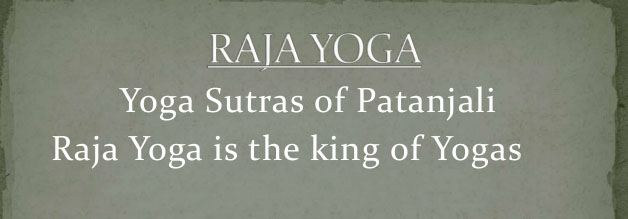 Raja Yoga is the king of Yogas. It is concerned directly with the mind. The Yogi sits at ease, watches the mind and silences the bubbling thoughts. The Yogi stills the mind, restrains the thought-waves and enters into the thoughtless state or asamprajnata samadhi.
Raja Yoga is the king of Yogas. It is concerned directly with the mind. The Yogi sits at ease, watches the mind and silences the bubbling thoughts. The Yogi stills the mind, restrains the thought-waves and enters into the thoughtless state or asamprajnata samadhi.
Patanjali’s Yoga system is written in sutras. A sutra is a terse verse. It is an aphoristic saying. It is pregnant with deep, hidden significance. Rishis of yore often expressed philosophical ideas and their realization in the form of sutras only. It is very difficult to understand the meaning of the sutras without the help of a commentary or a teacher who is well-versed in yoga. A Yogi with full realization can explain the sutras beautifully. Literally, sutra means a thread. Just as various kinds of flowers with different colors are nicely arranged in a string to make a garland, just as rows of pearls are beautifully arranged in a string to form a necklace, so also yogic ideas are well-arranged in sutras.
Raja Yoga holds that there is an eternal and omnipresent inert Prakriti (nature) and a plurality of omnipresent consciousness Purusha. Raja Yoga accepts a third principle, Ishvara (the supreme soul, God). The contact of the Purusha with Prakriti makes the latter evolve itself into its various effects. The Purusha, due to aviveka (non-discrimination), feels that it is an individual because of its identification with Prakriti and its modifications.
Raja Yoga concerns itself with the method of freeing the Purusha from this bondage through right effort. Yoga is, thus, more a practical way of attainment than a philosophical excursion into the realms of the spirit. In doing so, Yoga fulfills its own characteristic of being an utterly practical system of sadhana (spiritual practice).
When covered by the veil of ignorance (aviveka), the Purusha imagines that it is imperfect, incomplete, and that fulfillment can be had only in conjunction with Prakriti. The Purusha, then, so to say, begins to gaze at Prakriti; and in the light of this consciousness, the inert Prakriti commences its kaleidoscopic display of objects. The Purusha, due to prakriti-samyoga, appears to desire enjoyment of these objects. He acts, as it were. He seems to grasp the objects. Now, bondage is complete, and the vicious circle is kept up. Transmigration of the individual is the consequence of aviveka and its effects. Raja Yoga, by its scientific processes, cuts these three knots one by one and leads to kaivalya moksha, which is the realization of the true Purusha as independent of Prakriti and its evolutes.
Deep within everyone there is an abiding faith in a supreme being, someone to whom a seeker can look for help and guidance, for protection and inspiration. But the ego does not allow this to happen. Disentanglement of the Purusha from the ego alone can lead to its release from the snares of Prakriti. The ego can hardly be subdued by subjective analysis only; but it is easy to discriminate this ego as separate from the Purusha when it is voluntarily offered as a sacrifice at the altar of self-surrender to a Supreme Being, Ishvarapranidhana. This is the hypothesis of Raja Yoga, in addition to its exhortation to put forth effort.
Usually the mind is running in various directions; its rays are scattered. Sometimes it is self-forgetful, it is full of foolishness. When you try to practice concentration, the mind seems to get concentrated but gets distracted often. But, with prolonged and repeated practice of concentration, and repeating the Lord’s name, it becomes one-pointed. Later on, it is fully controlled. It is ready to be dissolved in the Supreme Purusha. Then you get asamprajnata samadhi.

 By
By 